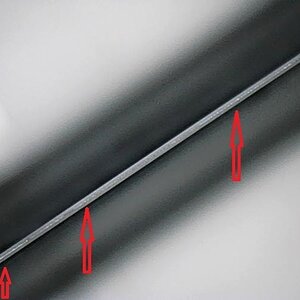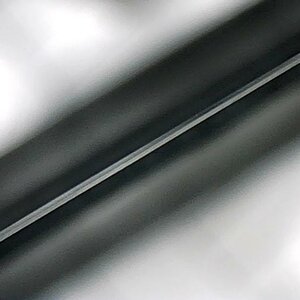Purpose
The obvious purpose of honing a razor is to take a razor that is dull and bringing it up to shave ready condition. This could range from minor touchups only requiring a couple of laps (defined as round trips) on a finishing hone to restorative honing needing advanced techniques such as layering tape and mixing honing strokes. The purpose of this wiki article is to demonstrate basic theory and technique, but the reader should defer to the Honing forums for information and discussions about when these techniques should be utilized.
Theory
The purpose of honing is very simply to remove steel from the edge of the razor in such a way as to achieve a symmetrical V shape that is keen enough to comfortably shave your face. Knives are considered "sharp" if they can shave arm hair easily. With razors, this is just the beginning stages of requisite keenness. Each razor has an original bevel that in time loses its keenness, becoming dull. With proper honing, metal is removed in such a fashion as to restore the keenness to the edge without causing significant damage to the spine of the razor known as "hone wear." This diagram demonstrates the basic theory effectively.
Types of Hones
There are several approaches to honing your razor. If you want to use stones, you have two basic types available for straight razor maintenance.
Alternatively, you can use lapping film or strops, which can be modified with the application of abrasive pastes in such a manner that renders them useful for in sharpening like a high grit finishing stone. See this page for more information.
There are a number of helpful threads detailing approaches to honing by Slash McCoy, including:
- Natural Stones
- Artificial Stones
Alternatively, you can use lapping film or strops, which can be modified with the application of abrasive pastes in such a manner that renders them useful for in sharpening like a high grit finishing stone. See this page for more information.
There are a number of helpful threads detailing approaches to honing by Slash McCoy, including:
Honing Techniques
There are many techniques that are available for successfully honing a razor. Each technique has strong and weak points which will not be covered in this article. For discussions about when to use each technique, the reader should search threads or post a new thread with questions in the Honing Forum
X Stroke
| The regular X stroke is a standard stroke for a blade with a straight edge (i.e., not smiling). The value of this stroke on narrow hones is that it allows for all of the blade to get equal contact with the stone. On a stone that is wide enough, the X stroke could be substituted with a straight stroke or a heel leading stroke. When utilizing an X stroke or straight stroke on a razor with a smile or a swayed spine, there is a potential to cause more hone wear than its desired while leaving the heel and the toe with a less than keen edge. The regular X stroke is not appropriate for every razor |
Swaying X Stroke
Rolling X Stroke
Half Stroke
Each of the honing strokes discussed have a "half stoke" derivative which involves reversing the action while maintaining contact with the hone. Essentially, a paintbrush or push and pull stroke. This technique can be useful in speeding up the process of removing metal. When utilizing half strokes, it is important that each side receive the same amount of strokes if the bevel is even. If the bevel is uneven, strokes may need to be adjusted in favor of the short side. Please visit the honing forum prior to attempting these techniques to discuss the appropriateness for your specific razor.
Circles
Utilizing circles in honing is a very effective way to speed up the bevel setting process. Essentially, the way to effectually incorporate circles is to keep the razor on the stone and move it in smooth, even circular motions. While using circles, it is very important to ensure that both sides get the same amount of strokes. In the bevel setting stage, it is typically recommended that 40 circles on each side followed by 10 X strokes be performed. Then, utilizing sharpness tests, determine if the bevel is properly set, repeat if necessary until the bevel is set. Circles can also be used throughout a progression of synthetic stones as well as on natural finishing stones.
Sharpness Tests
There are four standard tests for evaluating the keenness of a straight razor: TNT (Thumb Nail Test), TPT (Thumb Pad Test), HHT (Hanging Hair Test), and Shave test. Some of these tests are controversial, and it is important for each honer to develop an individual feel for analyzing the feedback provided by these tests. Dismissed by some as "parlor tricks," sharpness tests can be useful in helping the honer evaluate where the edge is in the journey to shave readiness.
TNT
The TNT is done by wetting the thumbnail and dragging the edge of the straight razor along without applying any pressure (blade weight only).
Interpretation
The TNT is very useful in determining where you are in the bevel setting process. A razor that has a properly set bevel will begin to cut into the thumbnail smoothly without a gritty sensation. If the blade slides over the thumbnail without cutting into the nail, the razor is not keen and additional work needs to be done on the stones. If the blade does cut into the thumbnail, but with a gritty sensation, the razor could be over-honed and corrective steps may need to be taken. Correcting over-honed razors is a topic beyond the scope of this article and should be discussed in the honing forum.
Drawbacks
While the TNT can be very helpful for determining if a bevel is set, it can provide false positives and is not really useful for determining the shave readiness of an edge. With a razor that has been maintained on pastes, a convex edge can develop. In order to restore the edge to a proper bevel, all of the convexity should be removed. One way to avoid this false positive is to very gently do a single bread-knife stroke on the bottom of glass rendering the edge unable to shave arm hair.
Another drawback of the TNT is that it can damage the edge of a shave ready razor. For this reason, it is generally not considered good to perform this test after the initial bevel setting process has been successfully completed.
Another drawback of the TNT is that it can damage the edge of a shave ready razor. For this reason, it is generally not considered good to perform this test after the initial bevel setting process has been successfully completed.
TPT
The Thumb Pad Test (TPT) is another sharpness test that utilizes the thumb pad to determine the keenness of the razor's edge. There are two schools of thought on how this is done. Whichever method is used, in order to increase the sensitivity of the honer's hand, it is helpful to hold the razor in your dominant hand with the edge facing up. Then, the non-dominant hand is used for testing with the fingers under the spine to enhance the sensitivity of the thumb. The TPT is conducted with a moist thumb pad.
Plucking the Edge
Some people people do the TPT by drawing their thumb across the edge (not along it) while feeling for indicators. The properly honed edge will give a slight tickling sensation when the thumb is gingerly dragged across. If there is a biting or catching sensation, there is a possibility that the razor has been over honed. When performing this test, the ideal edge will perform much differently than a sharp knife with a good cutting edge. If the sensation is similar to that of a sharp knife, the razor is not ready for a shave test.
Barber Manual Version
The TPT test as taught by Barbers Manuals differs in that the thumb pad is dragged along the edge of the razor (not across it). The properly honed edge will produce a slight sticking sensation. That is the razor cutting into the thumb of the tester. It is important not to use too much pressure because that will result in cutting into the thumb and drawing blood.
The TPT should be performed all along the edge until all of the edge performs equally.
The TPT should be performed all along the edge until all of the edge performs equally.
HHT
The Hanging Hair Test (HHT) is possibly the most controversial of all the sharpness tests. This is due to many factors, but because of this controversy, it has been dismissed by many as a "parlor trick." Many shavers have razors that can not pass the HHT that shave great, while others have razors that pass the HHT that do not shave well. Some honers believe that a truly keen edge will pass the HHT by silently causing the hair to fall upon coming in contact with the razor's edge. Others believe that the closer to perfection the edge gets, the more difficult the HHT is to pass. For determining the merits of these arguments, visit the honing forum.
For the HHT to be meaningful, it should be standardized as much as possible. This article on the coticule.be archive on the hanging hair test may prove useful for informing and evaluating your honing tests by offering a standardized test and a means to interpret the results of that test.
For the HHT to be meaningful, it should be standardized as much as possible. This article on the coticule.be archive on the hanging hair test may prove useful for informing and evaluating your honing tests by offering a standardized test and a means to interpret the results of that test.
Shave Test
The shave test is the ultimate and only truly accurate sharpness test for evaluating a honed edge. While every shaver has their own definitions of "shave ready", it is a commonly held standard that a shave ready razor will perform the Coup de Maître and ATG passes without pulling, skipping, or causing discomfort. Straight razor shavers claim that a truly shave ready razor will provide the best shaves of all the available shaving implements available when used by someone with the requisite skill to use it properly.
Common Problems
Bevel Setting
The most common problem that honers run into is that they have not done enough work at the bevel setting stage. Many times, new honers do not have a good understanding of how a properly set bevel should perform. If a bevel is not set properly, the end result will be unsatisfactory. The most important parts of a successful honing session is the first and last five percent (bevel setting and finishing).
There are a variety of different tests to establish whether the bevel has been correctly set. Shaving arm hair is one. A visual inspection of the bevel under light, ideally with a loupe, is the best way to establish that you are in fact ready to move up in your progression. These images from @H Brad Boonshaft clearly show what you are looking for:
An almost set bevel, with some reflections on the edge:

A fully set bevel, with no reflections:

There are a variety of different tests to establish whether the bevel has been correctly set. Shaving arm hair is one. A visual inspection of the bevel under light, ideally with a loupe, is the best way to establish that you are in fact ready to move up in your progression. These images from @H Brad Boonshaft clearly show what you are looking for:
An almost set bevel, with some reflections on the edge:

A fully set bevel, with no reflections:

Over Honing
It is very difficult to over hone a razor, according to honemeisters who have tried to do it. Essentially to over hone a razor, it requires a lot of strokes with a lot of pressure on a synthetic stone. There have not been any instances of over honing a razor on a natural stone that have been documented. It has been speculated that it can be done, though. This section is placed in the "Common Problems" section because it is suspected when honers are running into difficulties, but it is actually an uncommon problem that takes significant effort and bad technique to accomplish.
Uneven Strokes
It can be difficult for new honers to maintain an even stroke that effectively sharpens the entire edge. An uneven stroke can cause some areas of the edge to be keen while leaving another part dull. In order to determine how your stroke is performing, a honer can do a couple of things. The first is to watch the water on the stones along the front of the razor. If a line of water is moving all along the edge of the stroke, then the stroke is effecting the entire edge. Spots where water is not being moved in front of the razor shows where the razor is not remaining in contact with the stone. Another effective method is using a black Sharpie to mark along the edge of the razor. After doing a honing stroke, the honer can examine the edge and see how the black marks are reacting. Once all of the black marker is being removed by a single stroke, the honer can be confident that they are utilizing a good stroke.
Reprofiling the Heel
As a razor is honed the blade width narrows and the heel corner, (where the straight edge curves toward the spine) moves closer to the stabilizer. Once the corner gets close to the stabilizer, it is easy for the honer to hone on the stabilizer, which lifts the heel half of the razor off the stone, and causes all kinds of issues, the least of which is an unshaveable edge.
In this case, you want to reprofile the edge to keep the stabilizer off the stone when you hone the razor. H Brad Boonshaft has posted a pictorial walk through, detailing exactly how to accomplish this.
Videos
Acknowledgements
A special thank you to Bart Torfs at http://www.coticule.be. After 2 years of exhaustive research and effort, he has created one of the best websites on all things coticule including honing technique, information on stones, history and more. He graciously granted permission for Badger & Blade to use his images and content, and it is very much appreciated.
References
This page has been seen 42,835 times.
-
-
Created by onLast updated by on
-
